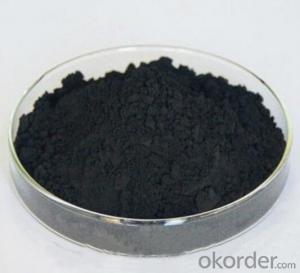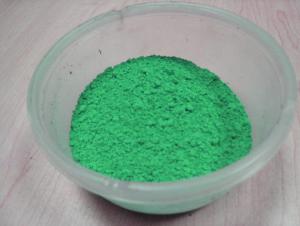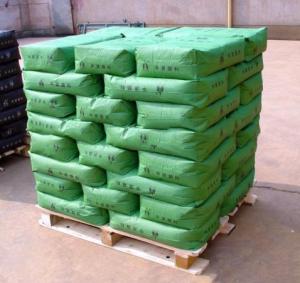Inorganic Green Pigments Chrome Oxide Green Paint Grade
- Loading Port:
- Shanghai Port
- Payment Terms:
- TT or LC
- Min Order Qty:
- 1 Metric Ton m.t.
- Supply Capability:
- 8000MT Per Year m.t./month
OKorder Service Pledge
OKorder Financial Service
You Might Also Like
Production Details Of Chrome Oxide Green :
Molecular Formula: Cr2O3
HS Code: 2819900000
CAS No. : 1308-38-9
Appearance: green powder
Specifications: (Quality Standard: HG/T 2775-1996)
Packing details of Chrome Oxide Green Powder :
25 kg/bag , or packaged into drums , or as your requirements .
Usage Of Chrome Oxide Green :
Mainly used in paint, glass, ceramics, building materials colorants, printing ink, metal polishing,smelting metal chromium, fire-proof material, etc.
Pigment Grade:
Item | Index | ||
Excellent Grade | First Grade | Qualified Grade | |
Appearance | Green Power | ||
Color Reference | Same | ||
Relative Color Strength | Strength | ||
Density g/cm3 | 4.8 | ||
Cr2O3 | ≥ 99.0% | ≥ 98.0% | ≥ 97.0% |
Cr+6 ppm | ≤ 5 | ||
Soluble Chrome | ≤ 0.03% | ≤ 0.03% | ≤ 0.03% |
105°C Volatile Matter | ≤ 0.3% | ≤ 0.3% | ≤ 0.3% |
Water Soluble | ≤ 0.1% | ≤ 0.4% | ≤ 0.7% |
Moisture | ≤ 0.15% | ≤ 0.3% | ≤ 0.5% |
PH of Water Solution | 7—7.5 | ||
Oil Absorption (g/ 100g) | 17 | ||
Residue on Sieve of 0.045 mm | ≤ 0.1% | ≤ 0.3% | ≤ 0.5% |
1200℃ Ingition Decerement | 0.05 | ||
Acid& Alkali Resistance | 5 | ||
Temperature Stability | 1000 | ||
Weather Fastness | 5 | ||



- Q: Please help me answer these Genetics problems. These are the problems that was assigned in the previous exams, but the professor doesn't provide the answer keys or a review session to go over these.Pigment in the mouse is produced only when the C allele is present. Individuals of the cc genotype have no color. if color is present, it may be determined by the A, a alleles. AA or Aa results in the agouti color, while aa results in the black color. In 3 crosses between agouti females whose genotypes are unknowns and males of the aacc genotype, the following phenotypic ratios were obtained. Female 1: 8 agouti 8 colorlessFemale 2: 4 agouti 5 black 10 colorless
- interior the 1st bypass AACC x aacc, discern a million will produce all AC gametes and discern 2 ac. Your F1 will all be AaCc. As all have the C allele they are going to be pigmented and as they're Aa they're going to all be agouti. Your F1 bypass is AaCc x AaCc. each and each discern can produce 4 gametes AC, Ac, aC, ac. To get all the genotypes you would be able to desire to entice a 4 x 4 Punnett sq.. each and each column and each and each row has between the 4 gametes in it and the cells comprise the blended genotypes. in case you count type up your genotypes you will discover 9 comprise the two A and C, those are agouti, 4 comprise cc, and all of those would be white regardless of the genotype at A, 3 comprise aa and C, those will all be black. So your phenotypic ratio would be 9:4:3 agouti: white: black the subsequent 3 crosses are all attempt crosses - you employ a recessive discern to artwork out the genotype of the different discern. a million. As lots of the offspring are colourless, you be attentive to that the two mothers and dads carry the c allele, as you pick cc for colourless mice. As there are no black mice, there is not any a allele interior the mum, as no aa offspring are produced. The bypass is AACc x aacc. woman gametes are AC or Ac and male gametes are all ac, offspring are the two AaCc or Aacc. 2. Is the opposite of bypass a million. There are black offspring so mom would desire to hold an a allele to furnish black mice, as there are no colourless ones, there is not any c allele interior the mum. you could write down the bypass and the F2 effect now. 3. This time all hues are produced, so the mum would desire to hold the two a and c alleles. Her genotype is AaCc, she would be able to offer 4 gametes as interior the 1st bypass and you will artwork out the resultant genotypes and phenotypes interior the F2.
- Q: My wife went to the eye doctor to get new glasses (because she couldn't renew her driver's license with her glasses she had been using), and the doctor said that she wasquot;losing pigment" in both of her eyes. He said not to worry, but he wants her to make an appointment every 6 months, instead of just once a year.What does it (her losing pigment in her eyes) mean? Is it really nothing to worry about?(My wife doesn't seem worried, she hates going to doctor's but she trusts them when she goes to them; she doesn't ask questions-- she feels that if she needed to know something the doctor would tell her.)
- Pigment is what gives your eyes color...meaning, if you have brown eyes, then you have pigment *if your eyes are blue, you lack pigment in your eyes*. It just means that color is disappearing from her eyes...have you noticed a slight color change? Keep an eye on it and her and see if anything else goes wrong. Best of luck to both of you.
- Q: If you could explain it to me I would be very happy!
- Accessory pigments are light-absorbing compounds, found in photosynthetic organisms, that work in conjuction with chlorophyll a. They include other forms of this pigment, such as chlorophyll b in green algal and higher plant antennae, while other algae may contain chlorophyll c or d. In addition, there are many non-chlorophyll accessory pigments, such as carotenoids or phycobiliproteins which also absorb light and transfer that light energy to photosystem chlorophylls. Some of these accessory pigments, particularly the carotenoids, also serve to absorb and dissipate excess light energy, or work as antioxidants.
- Q: How many pigments does grass reflect?
- Pigments are the colors that make grass look green. They are the pigments that do photosynthesis. Grass looks green because it reflects green light. It reflects the wavelengths of light that have the frequency of green light. Grass has other pigments that we do not see through the chlorophyll, but it is the light that is reflected.
- Q: Can someone describe the role of accessory pigments in photosynthesis?
- Accessory Pigments In Plants
- Q: i bought the new neon pro pigments from mac , well 5 out of the six and i also bought 'basic red'i want to use these as eye shadows but i dont know howi also bought mac mixing medium for face and body but lol , i dont know how to use any of this stuffwhat can i do to use this stuff i mean will it turn out like regular eyeshadow if i use it right? will there be a shine to it? it will reduce fall out? should i put the mixing medium on my eye first , then let dry?do i need to possibly press the pigments in a pot with some kind of eye shadow liquid?i also bought the mascara mixing medium but want to know exactly what to do with thatand also , can i mix any of the pigments with lipgloss?http://cn1.kaboodle /hi/img/2/0/0/119/a/AAAAAlrx1LUAAAAAARmgiA.jpg
- when you use a pigment, it's always better to apply it wet since it's a loose shadow. with the mixing medium, put a few drops of it on to some kind of surface, like the lid of the jar or even on your hand. if you dropped it in the lid, tap a little shadow into the lid and mix it with your brush. you want a thick, kind of pastey consistency. if your put it on your hand, did your brush into the drops of mixing medium and then then dip the wet brush into the pigment jar. then all you gotta do is apply it to your lid. but make sure you put a base on your lid before applying! good luck! =]
- Q: Can somebody answer this in AP BIO language please
- A pigment molecule absorbs at specific wavelength(s), meaning that when light of a specific wavelength is incident to the molecule only certain wavelengths are absorbed while others are transmitted. The spectrophotometer emits monochromatic light (light of only one wavelength) which passes through the pigment molecule and a detector determines the amount of light that is either absorbed or transmitted by the sample. This is done at wavelengths from the UV (180-330 nm) to the visible (330-700 nm) and the light that is either transmitted or absorbed is detected by the spectrophotometer and is able to be graphed with absorbance representing the y-axis and wavelength representing the x-axis. The resultant graph will depict the absorption spectrum of that particular pigment molecule. Hope that helps.
- Q: What pigments take part in photosynthesis?
- Chlorophylla-a is the primary pigment for photosynthesis in plants, but the range of light absorption is extended by chlorophyll-b, beta-carotene (a carotenoid).
- Q: Hi what is pigment?i went on mac cosmetics and they sell all different kinds of stuff called pigment. I want to use it to make lip gloss but is it safe for my lips?please answer soon!
- the pigment on MAC that you were looking at is like loose eyeshadow. it's essentially coloured powder and it can be used for many different things- including in lip-gloss. it is perfectly fine to use on your lips, and using MAC is a good choice, as they have some of the best pigments I've come across.
- Q: Many of the microorganisms found on environmental surfaces are pigmented. Of what possible advantage is the pigment?
- So they can absorb different light frequencies to use for energy (from photosynthesis). Light travels in water according to the frequency (wavelength). So different pigmented organisms are able to exist in different environments, possibly reducing competition with other forms.
1. Manufacturer Overview
| Location | Henan, China |
| Year Established | 1995 |
| Annual Output Value | Above US$100 Million |
| Main Markets | 20.00% North America 20.00% South America 10.00% Eastern Europe 10.00% Southeast Asia 10.00% Northern Europe 10.00% South Asia 10.00% Western Europe 5.00% Africa 5.00% Mid East |
| Company Certifications | REACH, ROSH,SVHC 53 Items Certificate ,SGS,CIQ,ISO9001:2008 |
2. Manufacturer Certificates
| a) Certification Name | |
| Range | |
| Reference | |
| Validity Period |
3. Manufacturer Capability
| a) Trade Capacity | |
| Nearest Port | Qingdao Port, China |
| Export Percentage | 51% - 60% |
| No.of Employees in Trade Department | 100 People |
| Language Spoken: | English; Chinese;Spainsh; Farsi;French;German |
| b) Factory Information | |
| Factory Size: | Above 600,000 square meters |
| No. of Production Lines | Above 3 |
| Contract Manufacturing | Design Service Offered; Buyer Label Offered |
| Product Price Range | Rock Bottom Price With Best Quality |
Send your message to us
Inorganic Green Pigments Chrome Oxide Green Paint Grade
- Loading Port:
- Shanghai Port
- Payment Terms:
- TT or LC
- Min Order Qty:
- 1 Metric Ton m.t.
- Supply Capability:
- 8000MT Per Year m.t./month
OKorder Service Pledge
OKorder Financial Service
Similar products
Hot products
Hot Searches
Related keywords



























